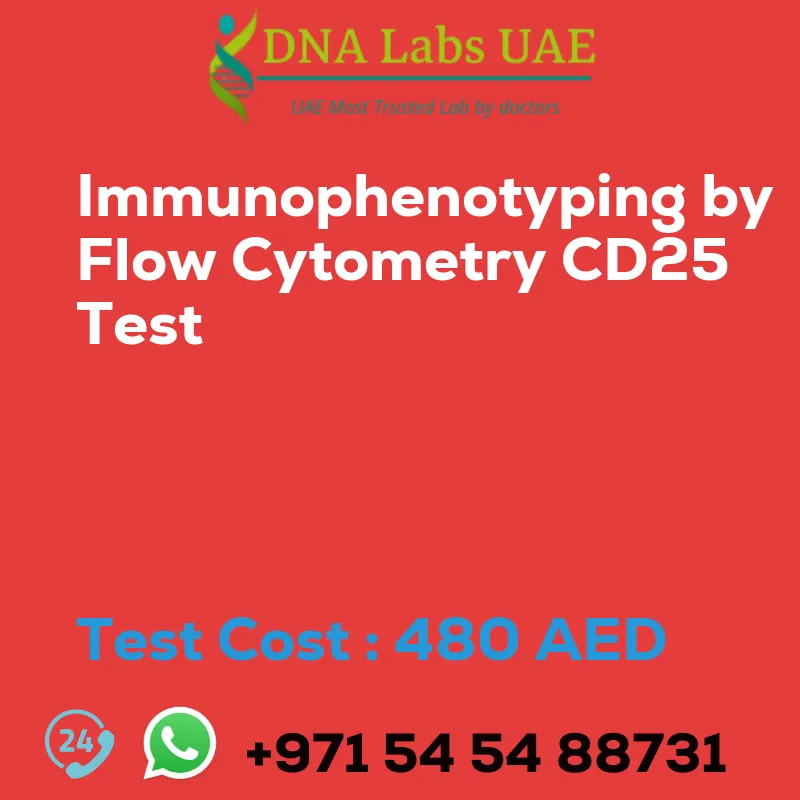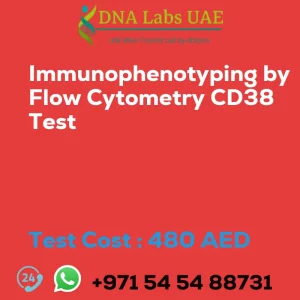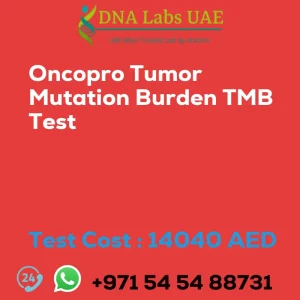IMMUNOPHENOTYPING BY FLOW CYTOMETRY CD25 Test
Test Cost: AED 480.0
Symptoms and Diagnosis
The CD25 test is an immunophenotyping assay that is performed using flow cytometry. CD25, also known as interleukin-2 receptor alpha chain, is a cell surface marker that is expressed on activated T cells, B cells, and natural killer cells. The CD25 test is used to identify and quantify the number of CD25-positive cells in a sample. This can be helpful in diagnosing and monitoring certain conditions, such as autoimmune diseases, lymphomas, and leukemias.
Test Components and Price
- Sample Condition: 3 mL (2 mL min.) whole blood in 1 Lavender Top (EDTA) tube and 3 mL (2 mL min.) whole blood in 1 Green Top (Sodium Heparin) tube OR 2 mL (1 mL min.) Bone marrow in 1 Green Top (Sodium heparin) tube. Ship immediately at 18-22°C. DO NOT REFRIGERATE OR FREEZE. Specify time, date, and clinical details on the test request form.
- Report Delivery: Sample Daily by 9 am; Report Same day
- Method: Flow Cytometry
- Test Type: Cancer
- Doctor: Oncologist, Hematologist
- Test Department: FLOW CYTOMETRY
- Pre Test Information: Give brief clinical history.
Test Details
During the CD25 test, a blood or tissue sample is collected from the patient. The sample is then treated with antibodies that specifically bind to CD25 molecules on the surface of cells. These antibodies are conjugated to fluorescent dyes, which allow for the detection of CD25-positive cells by flow cytometry.
Flow cytometry is a technique that uses lasers to analyze the physical and chemical properties of individual cells as they flow in a single file through a narrow channel. The fluorescently-labeled cells are passed through the laser beam, and the emitted light is detected by detectors. The data obtained from the detectors is then analyzed to determine the percentage of CD25-positive cells in the sample.
The CD25 test can provide valuable information about the immune status of a patient and help guide treatment decisions. It is a widely used technique in clinical and research settings for immunophenotyping and immune monitoring.
| Test Name | IMMUNOPHENOTYPING BY FLOW CYTOMETRY CD25 Test |
|---|---|
| Components | |
| Price | 480.0 AED |
| Sample Condition | 3 mL (2 mL min.) whole blood in 1 Lavender Top (EDTA) tubeAND 3 mL (2 mL min.) whole blood in 1 Green Top (Sodium Heparin) tube OR 2 mL (1 mL min.) Bone marrow in 1 Green Top (Sodium heparin) tube. Ship immediately at 18\u0192??22?\u00f8C. DO NOT REFRIGERATE OR FREEZE. Specify time, date and clinical details on test request form. |
| Report Delivery | Sample Daily by 9 am; Report Same day |
| Method | Flow Cytometry |
| Test type | Cancer |
| Doctor | Oncologist, Hematologist |
| Test Department: | FLOW CYTOMETRY |
| Pre Test Information | Give brief clinical history. |
| Test Details |
The CD25 test is an immunophenotyping assay that is performed using flow cytometry. CD25, also known as interleukin-2 receptor alpha chain, is a cell surface marker that is expressed on activated T cells, B cells, and natural killer cells. The CD25 test is used to identify and quantify the number of CD25-positive cells in a sample. This can be helpful in diagnosing and monitoring certain conditions, such as autoimmune diseases, lymphomas, and leukemias. During the test, a blood or tissue sample is collected from the patient. The sample is then treated with antibodies that specifically bind to CD25 molecules on the surface of cells. These antibodies are conjugated to fluorescent dyes, which allow for the detection of CD25-positive cells by flow cytometry. Flow cytometry is a technique that uses lasers to analyze the physical and chemical properties of individual cells as they flow in a single file through a narrow channel. The fluorescently-labeled cells are passed through the laser beam, and the emitted light is detected by detectors. The data obtained from the detectors is then analyzed to determine the percentage of CD25-positive cells in the sample. The CD25 test can provide valuable information about the immune status of a patient and help guide treatment decisions. It is a widely used technique in clinical and research settings for immunophenotyping and immune monitoring. |







